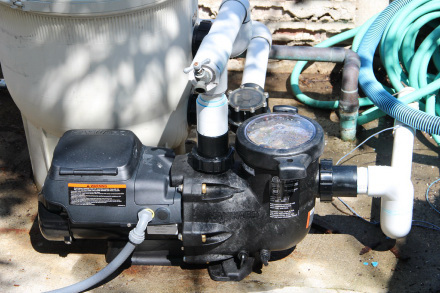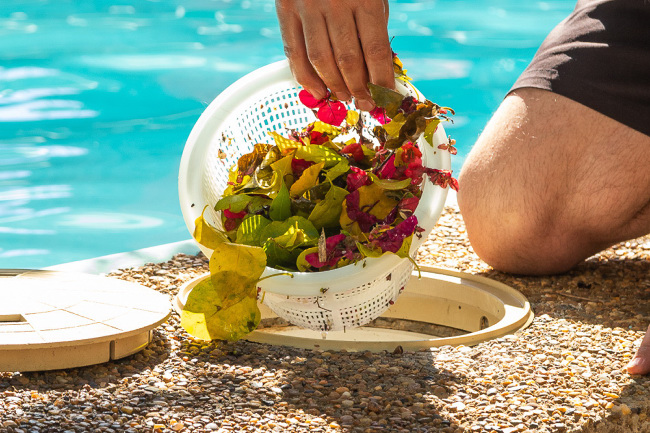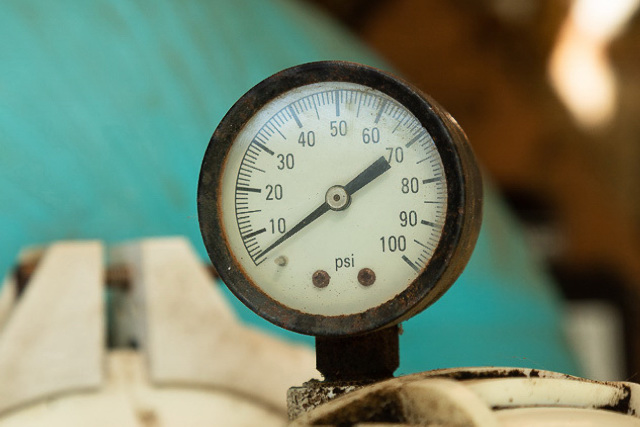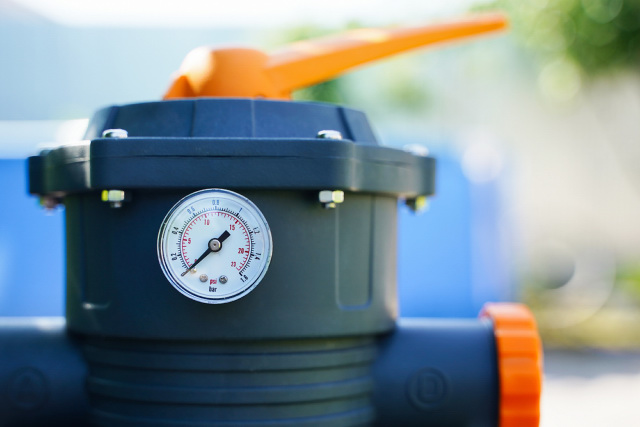Pool pumps play an essential role in your pool’s maintenance. But what happens when the pump itself starts losing pressure or the pressure begins to fluctuate? Do you replace it or simply get it fixed?
If you’re facing these issues, there’s no need to worry! We’ll guide you step by step on why your pump may not be functioning properly and what you can do to fix the problem.

Article Contents
20 Reasons Why Your Pool Pump Has Lost Pressure
In general terms, low filter pump pressure indicates an issue in the system on the “suction side” of the pump. The suction side is the side of the pump that draws the water in from the pool. The “pressure side” of the pump is where the water exits from the pump and is sent to the pool filter.
There may be several reasons as to why your pool pump is losing pressure. The trick is to check one fault at a time to narrow down and find the culprit. Problem elimination isn’t too time-consuming and you can ensure that you’re on the right track before calling a professional for help.
1. Low Pool Water Level
Low pool level may also cause the pool pump to lose pressure. You should ensure that the water level in the pool is always maintained above the skimmer basket. This prevents air from being sucked into the system.
The solution is easy to check and all you need to do to fix it is fill up your pool with more water.
2. Loose or Leaking Union or Coupling in the Pipes
When you set up your pool pump, there are a lot of pipes that need to be joined. Sometimes the joins in the fittings have gotten old and have sprung a leak. In any case, it’s important to check the connections on the suction side of your pump to eliminate any air bubbles that might have entered the system.
You can do this by closely inspecting the joins in the pipe. Check they are tight too.
3. Congested or Blocked Skimmer Basket
Skimmer baskets catch debris and dry leaves in the pool and prevent them from getting into your pool’s pump. However, over time, debris and dry leaves may accumulate and congest the skimmer basket. This restricts the flow of water consequently lowering the pressure of the pool pump.

You must empty the basket regularly to allow consistent water flow and pressure. Doing this also permits you to see the condition of the basket and replace it if necessary. A broken skimmer basket could allow debris through it to block up your pool’s pump.
4. Pump Lid Not Sealing
A suction leak at the pump lid can cause a decrease in pressure. Instead of sucking water, the pump starts to suck air.
First, check the lid is screwed on correctly and seated as it should be. Check for cracks in the lid. And check the pump lid seal is in good condition and the threads on the lid and the pump housing are undamaged.
Sometimes pump lids won’t undo, check out our article on that:
How to Undo a Stuck Pool Pump Lid Without Breaking It
I would highly recommend you try putting a little seal or o-ring lubricant on the seal. It can do wonders for air leaks.
- Ensures a more reliable seal on pumps, motors, lights.
- Extends the life of seals
- Use it on pump lids, pump seals, filter seals etc.
If the pump lid seal is cracked or deformed, you’ll need to replace it. The lid should be replaced if it is cracked or the threads are damaged.
5. Clogged Impeller
The impeller is the part of the pump that spins and it looks like a fan. It sucks the water into the pump. Sometimes impellers get debris caught in them and if this occurs, the result can be low pressure.
A damaged skimmer basket can cause this or if the pump has been run without the skimmer basket. It also occurs if debris gets past the pump strainer basket.
To check this, turn off the pump at the breaker. Open the pump lid and take out the strainer basket. Now stick your hands or a screwdriver into the pipe where the impeller is located and pull any debris out.
6. Damaged Impeller
Generally, the impeller lasts as long or even longer than the pool pump itself. However, over the years, it may wear out or damage with regular use. If the impeller isn’t working efficiently, this can cause low pressure. Being responsible for maintaining pressure, the impeller should be on your routine checklist in case the pressure levels drop.
7. Cracked Pump Housing
Anything that lets air into the systems on the suction side of the pump will cause low pressure readings on your filter pressure gauge.
Check the housing around your pump for cracks that could potentially let air in.
8. Congested Pump Strainer Basket
The strainer basket, too, is similar to a skimmer basket as it collects unwanted debris, dry leaves, and other fragments you don’t want in your pool.
It’s located in the pump and its job is to stop debris from entering into the impeller and potentially blocking the pump. And it keeps large debris out of the filter and lines to the filter which could potentially get blocked up.
The strainer basket needs to be maintained properly in order to keep a consistent pressure flow in the pool. A blocked up strainer can result in your pump having low pressure. You can check this by unscrewing the lid of the pump and emptying the basket out – make sure the pump is off when you do this.
9. Pipe Diameter is Too Small or the Pipes are Blocked
Anything that restricts the water flow on the suction side of the pump will cause low water pressure. That includes a blockage between the skimmer and the pump as well as pipes that are too small.
To check for a blockage, remove the skimmer basket and check for debris in the pipe. If you suspect there is debris where you can’t reach it, you may be able to use a “Drain Jet” tool. You attached this to your garden hose and put it in the pipe. It then expands and blocks off the pipe while pushing water at pressure through the pipe – which will hopefully clean the blockage.
10. Faulty Pressure Gauge
- Ensure you have an accurate pressure reading
- Cheap to buy & easy to replace
- The replacement range will fit most filters
In case everything is working well and you have eliminated most of the possible reasons why your pool is losing pressure, you might just want to check your pressure gauge.
A faulty pressure gauge will not allow your pool pump to pass the adequate pressure that is required. The needle may not fluctuate with different pressure levels or it may go down to zero despite the pool pump running.

To check this, turn the pump off and on. Watch the pressure gauge needle to see if it moves. If it doesn’t go down when the system is off and back up when you turn it on, it’s definitely faulty.
This check will tell you if the gauge is faulty, it won’t tell you if the pressure reading is correct. Replacing it is the only solution to know if that’s the issue or not.
11. Pump Too Far from Pool
Perhaps you’ve moved your pool equipment or decreased the size of your pump. The added distance from the pool may mean that your pump is now undersized from the job and cannot generate the pressure needed.
12. Too Much Additional Equipment
Adding additional equipment to your pool’s system can mean the original pump is now undersized. To check this, try turning off water features, heaters, pool cleaners and other equipment. Watch the pressure gauge while you do this.
If the pressure rises and returns to normal, you’ll need a larger pump to cope with the additional demand.
13. Leakage In The Underground Pipe
If you have come so far down the list and have found nothing wrong with your pool pump, the next diagnosis is finding the leakage in the underground pipe. Underground pipes can get broken by tree roots or if the earth moves.
The leak will be on the suction side of the pump, that is between the skimmer box and the pump.
The only solution is to dig them up and have them replaced with new pipes so as to ensure that there is no leakage again.
How To Know The Pool Pump Has Lost Pressure?
It’s quite easy to notice that the pool pump has lost pressure. Here are a few physical cues that you should look out for:
- The water jets have a slow return: The water is either trickling down slowly or the flow is sluggish. It’s evident the pool pump is not building adequate pressure.
- The pressure gauge shows a low reading: Quite obviously, the pressure gauge is present for you to read out pressure. Most pool filter systems should have a pressure of 50-75Kpa (kilopascal) or 10 – 25 psi.
An accurate pressure gauge will give you the correct reading and you can identify whether the pressure is actually maintained or not.
- Sluggish pool cleaners: If your pool cleaners are sluggish and aren’t working as efficiently as they usually do, it’s a sign that the pool pump is losing pressure and you might need to further investigate.
Related Reading: 12 Reasons Pool Pumps Leak (and How to Fix)
What Is The Ideal Pool Pump Pressure?
The ideal pressure in your pool depends on several factors that range from the size of your pool, the size of your pool pump, and the sort of water flowing in your pool. A general rule for pressure in the pool is a reading between 10 to 25 PSI.
When you get a new pool pump and a filter system installed, it’s important to take a baseline reading. This is the reading you compare your future readings with when everything starts operating optimally.
In case the pool pump’s reading fluctuates vastly, you need to check for the causes as to why it’s different. Therefore, it’s always a great idea to take readings on a regular basis. This can be done weekly or bi-weekly depending on your usage.
Related Reading: 8 Reasons Filter Pump Pressure is High (And How to Fix)
What is Considered Low Pressure in a Pool Pump?
The pressure of each pool filter will vary with most pools reading between 10 and 25 PSI. Anything lower than what is normal for your pool is considered low pressure.
That’s why it’s best to take a baseline reading after backwashing your pool’s filter – this will be the lowest pressure you should see on the pressure gauge.
If you’re not sure how to backwash your pool filter, we have an article here: How to Backwash a Pool Filter & How Often
Final Thoughts
There may be plenty of reasons why pool pumps lose pressure. While we may have given you a detailed guide, there may be other factors that may come into play too. Most of the time, it’s easy to determine the cause. However, if you’re still struggling with it, a professional is just a call away!
Related Reading: 6 Signs a Pool Pump Capacitor Is Bad (and how to test)



